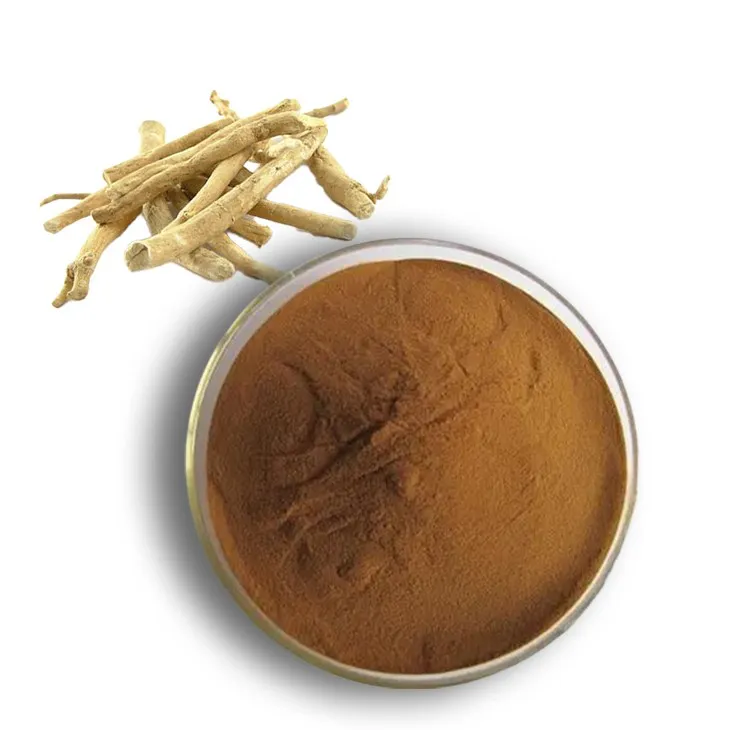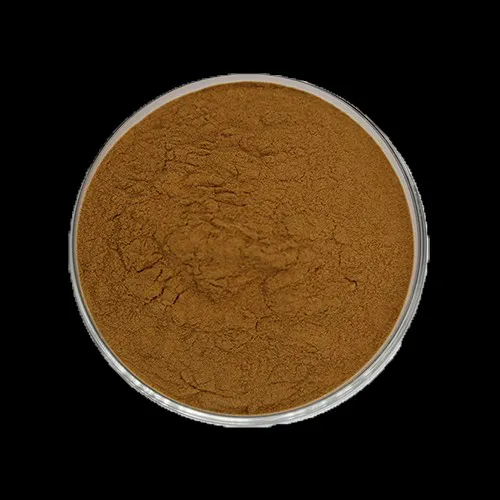- 0086-571-85302990
- sales@greenskybio.com
How to extract Withania somnifera extract from plants?
2024-11-29

Cultivation of Withania somnifera
Before the extraction process, it is crucial to cultivate Withania somnifera in appropriate environmental conditions.
Withania somnifera, also known as Ashwagandha, is a plant native to India and North Africa. It thrives in warm
and dry climates.
The soil quality also plays a significant role. Well - drained, sandy loam soils are preferred. Adequate sunlight
exposure is essential for its growth. Typically, it requires at least 6 - 8 hours of sunlight per day. Watering
should be carefully managed. Over - watering can lead to root rot, while under - watering can stunt the plant's
growth. Therefore, a balanced watering schedule based on the local climate and soil moisture retention capacity
is necessary.
Moreover, proper spacing between plants is important to ensure sufficient air circulation and nutrient uptake.
This helps in the healthy growth of the plant and the accumulation of active substances within it, which are
crucial for the extraction of high - quality extract.

Traditional Extraction Method: Maceration
Maceration is one of the traditional and relatively simple methods for extracting Withania somnifera
extract.
Preparation of Plant Material
Firstly, the plant parts such as the roots, leaves, or stems of Withania somnifera need to be collected. These plant parts should be clean and free from any contaminants. After collection, they are carefully crushed into smaller pieces. This crushing process increases the surface area of the plant material, which facilitates better interaction with the solvent during the extraction process.
The Maceration Process
A suitable solvent is then selected. Commonly used solvents include ethanol, methanol, or water. In the
maceration process, the crushed plant parts are immersed in the solvent at room temperature. This
immersion is carried out for a relatively long time, which can range from several days to weeks. During this
period, the solvent gradually penetrates into the plant cells. Through a process of diffusion, the solvent
dissolves the target extract, which contains various bioactive compounds such as withanolides.
One of the advantages of maceration is its simplicity. It does not require complex equipment. However, it
also has some drawbacks. The extraction time is relatively long, and the extraction efficiency may not be as
high as some modern extraction methods.
Separation of the Extract
After the maceration period, the mixture of the plant material and the solvent needs to be separated. This can be achieved through filtration. A filter paper or a filtration device can be used to separate the liquid extract from the solid plant residue. The resulting liquid extract contains the dissolved Withania somnifera extract along with the solvent. If ethanol or methanol is used as the solvent, further steps may be required to remove the solvent and obtain a more concentrated extract.

Modern Extraction Technique: Ultrasonic - Assisted Extraction
Ultrasonic - Assisted Extraction (UAE) is a modern and more efficient method for extracting Withania
somnifera extract.
Principle of Ultrasonic - Assisted Extraction
Ultrasonic waves are applied to the solvent - plant material mixture. These ultrasonic waves create cavitation in the solvent. Cavitation refers to the formation, growth, and implosion of small bubbles in the solvent. When these bubbles implode, they generate high - energy shockwaves and micro - jets. These physical phenomena enhance the mass transfer between the solvent and the plant cells. The shockwaves can disrupt the cell walls of the plant cells, allowing the solvent to more easily penetrate into the cells and dissolve the target extract.
Procedure of Ultrasonic - Assisted Extraction
Similar to the maceration method, the plant parts of Withania somnifera are first prepared by cleaning and
crushing. Then, the crushed plant material is placed in a suitable solvent. The solvent - plant material
mixture is then subjected to ultrasonic waves. The ultrasonic treatment time can vary depending on the
specific requirements, usually ranging from 15 minutes to several hours.
After the ultrasonic treatment, the mixture is filtered to separate the extract from the plant residue. The
resulting extract is often of higher quality and contains a higher concentration of bioactive compounds
compared to the maceration method. This is because the ultrasonic - assisted extraction can extract more
efficiently the target compounds from the plant cells in a shorter time.
Advantages of Ultrasonic - Assisted Extraction
- Higher extraction efficiency: As mentioned above, the cavitation effect generated by ultrasonic waves
can significantly improve the mass transfer between the solvent and the plant cells, leading to a higher
extraction yield of the Withania Somnifera Extract.
- Shorter extraction time: Compared to the traditional maceration method, ultrasonic - assisted
extraction can complete the extraction process in a much shorter time. This not only saves time but also
reduces the cost associated with the extraction process.
- Better quality of the extract: The extract obtained through ultrasonic - assisted extraction often has
a higher content of bioactive compounds. These bioactive compounds are responsible for the various
pharmacological properties of Withania Somnifera Extract, such as antioxidant, anti - inflammatory, and
adaptogenic properties.

Subsequent Purification Steps
Regardless of the extraction method used, subsequent purification steps are necessary to obtain a high - quality
Withania Somnifera Extract.
Chromatography Techniques
Chromatography is a powerful technique for separating and purifying the Withania somnifera extract.
There are different types of chromatography techniques that can be used, such as high - performance liquid
chromatography (HPLC) and column chromatography.
In HPLC, the extract is passed through a column filled with a stationary phase. A mobile phase is also used to
carry the extract through the column. Different components in the extract have different affinities for the
stationary and mobile phases. Based on these differences, the components are separated as they pass through
the column. This allows for the isolation and purification of specific bioactive compounds in the Withania
somnifera extract.
Column chromatography works on a similar principle. However, it may use different types of stationary and
mobile phases depending on the specific requirements. Column chromatography can be a more cost - effective
option for large - scale purification of the extract.
Evaporation and Drying
After the chromatography step, the purified extract may still contain some solvent. To obtain a dry and
concentrated extract, evaporation and drying steps are carried out. The solvent is evaporated using
techniques such as rotary evaporation. Rotary evaporation involves heating the extract - solvent mixture
under reduced pressure. The solvent evaporates, leaving behind a more concentrated extract.
After evaporation, the extract may be further dried in a desiccator or under vacuum to remove any remaining
moisture. This results in a dry, powdered Withania somnifera extract that can be stored and used for various
applications, such as in the pharmaceutical, nutraceutical, or cosmetic industries.

Conclusion
Extracting Withania somnifera extract from plants involves a series of steps from cultivation to extraction and purification. The traditional maceration method has its simplicity but relatively lower efficiency, while the modern ultrasonic - assisted extraction method offers higher efficiency and better quality of the extract. Subsequent purification steps, such as chromatography, evaporation, and drying, are essential to obtain a high - quality extract. With the increasing demand for natural products and their potential health benefits, the extraction and purification of Withania somnifera extract will continue to be an important area of research and development.
FAQ:
What are the suitable environmental conditions for cultivating Withania somnifera?
Withania somnifera typically thrives in warm, dry climates. It prefers well - drained soil and充足的 sunlight. Adequate watering without waterlogging is also important for its growth.
What are the advantages of ultrasonic - assisted extraction over maceration?
Ultrasonic - assisted extraction has several advantages over maceration. In maceration, the process is slow as it depends on the natural diffusion of the solvent into the plant cells at room temperature. However, ultrasonic - assisted extraction uses ultrasonic waves to create cavitation in the solvent. This cavitation enhances the mass transfer between the solvent and the plant cells, which significantly improves the extraction efficiency compared to maceration.
Why is purification necessary after extracting Withania somnifera extract?
After extraction, purification is necessary because the initial extract may contain impurities, such as other plant components that are not part of the desired Withania somnifera extract. Purification steps like chromatography techniques help to separate and purify the extract further, ensuring that we obtain a high - quality and pure Withania somnifera extract.
Can other solvents be used in the maceration process?
Yes, different solvents can be used in the maceration process depending on the nature of the target extract. Commonly used solvents include ethanol, methanol, and water. Each solvent has different solubility characteristics, and the choice of solvent may affect the extraction efficiency and the quality of the final extract.
How long does the maceration process usually take?
The maceration process can take a relatively long time, usually ranging from several days to weeks. The exact duration depends on factors such as the nature of the plant material, the solvent used, and the desired concentration of the extract. During this time, the solvent gradually penetrates the plant cells to dissolve the target extract.
Related literature
- Optimization of Withania somnifera Extract Production: A Review"
- "Advanced Extraction Techniques for Withania somnifera: Current Trends and Future Prospects"
- "The Chemical Composition and Bioactivity of Withania somnifera Extracts: A Comprehensive Study"
- ▶ Hesperidin
- ▶ Citrus Bioflavonoids
- ▶ Plant Extract
- ▶ lycopene
- ▶ Diosmin
- ▶ Grape seed extract
- ▶ Sea buckthorn Juice Powder
- ▶ Fruit Juice Powder
- ▶ Hops Extract
- ▶ Artichoke Extract
- ▶ Mushroom extract
- ▶ Astaxanthin
- ▶ Green Tea Extract
- ▶ Curcumin
- ▶ Horse Chestnut Extract
- ▶ Other Product
- ▶ Boswellia Serrata Extract
- ▶ Resveratrol
- ▶ Marigold Extract
- ▶ Grape Leaf Extract
- ▶ New Product
- ▶ Aminolevulinic acid
- ▶ Cranberry Extract
- ▶ Red Yeast Rice
- ▶ Red Wine Extract
-
Red Date Extract
2024-11-29
-
Black Pepper Extract
2024-11-29
-
Chia Seed Powder
2024-11-29
-
Tormentil Extract
2024-11-29
-
American Ginseng Root Extract
2024-11-29
-
Quercetin
2024-11-29
-
Sophora Flavescens Root Extract
2024-11-29
-
Green Tea Extract
2024-11-29
-
Peppermint Extract Powder
2024-11-29
-
Giant Knotweed Extract
2024-11-29





















